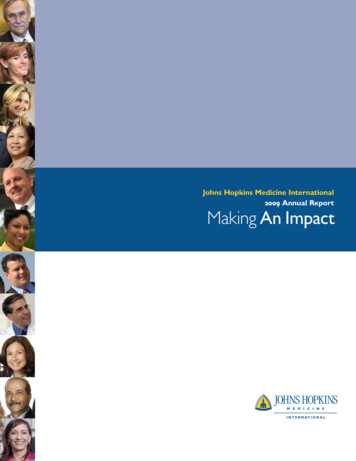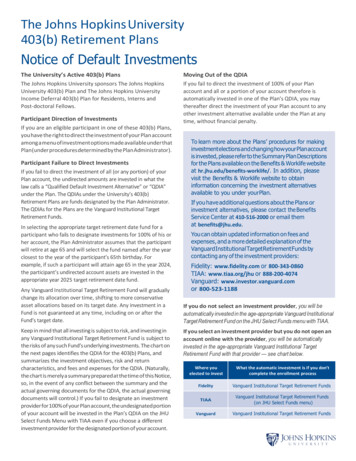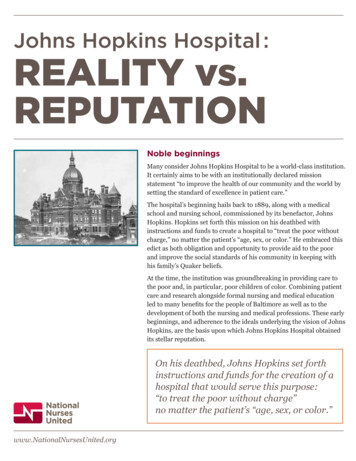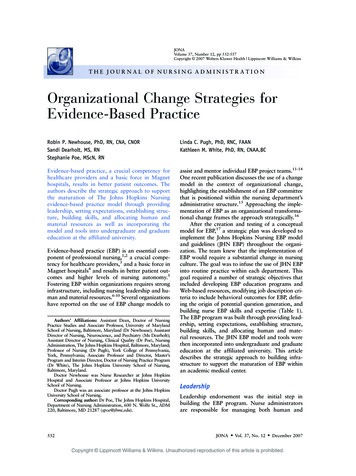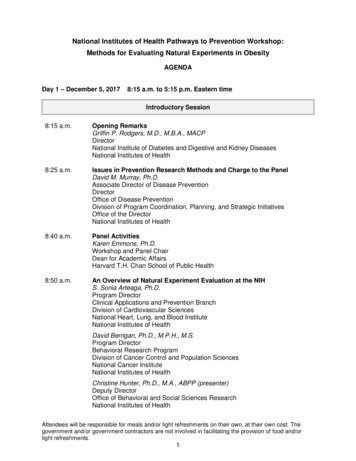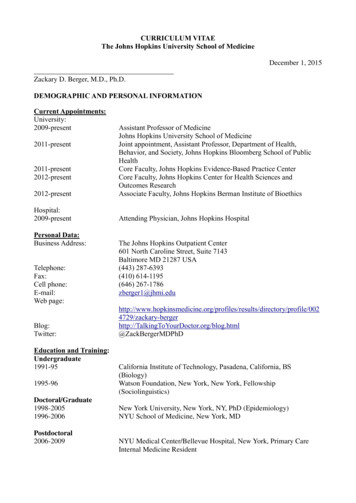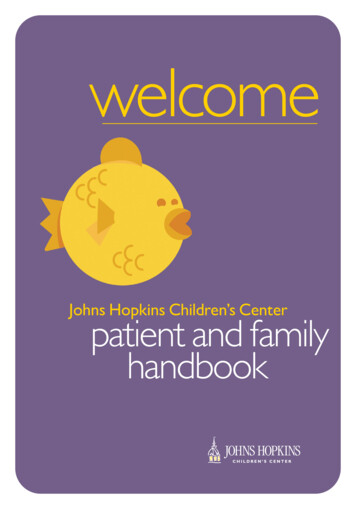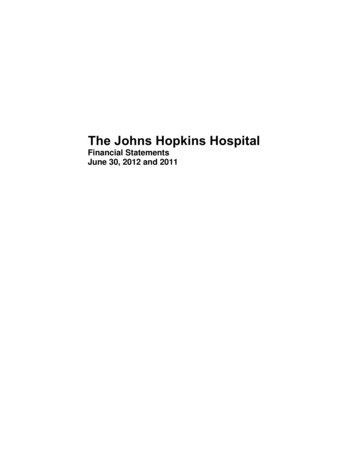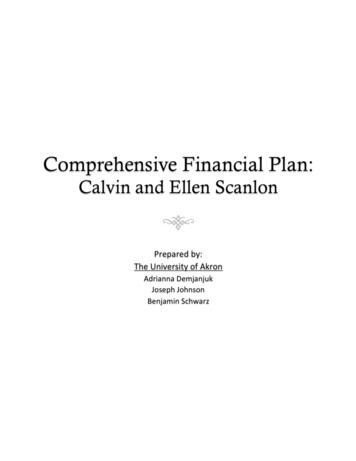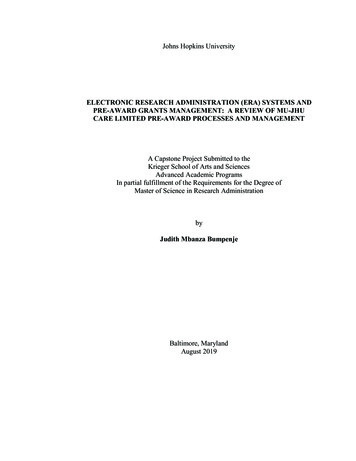
Transcription
Johns Hopkins UniversityELECTRONIC RESEARCH ADMINISTRATION (ERA) SYSTEMS ANDPRE-AWARD GRANTS MANAGEMENT: A REVIEW OF MU-JHUCARE LIMITED PRE-AWARD PROCESSES AND MANAGEMENTA Capstone Project Submitted to theKrieger School of Arts and SciencesAdvanced Academic ProgramsIn partial fulfillment of the Requirements for the Degree ofMaster of Science in Research AdministrationbyJudith Mbanza BumpenjeBaltimore, MarylandAugust 2019
AbstractResearch Administration is a huge endeavor with several processes to manage andmany regulations to follow. A common challenge with research administration is thebroad scope of work required to maintain compliance and transparency in the processes.This is further encumbered by the onerous agency regulations specifically for federallyfunded projects. The Makerere University (MU)-Johns Hopkins University (MU-JHU)Care Limited receives majority of financial support for its research projects from U.S.federal funds. MU-JHU receives most of its funding support as subawardees with a fewprime awards and there is a growing need to increase the number of prime awards at theinstitution. The need to increase prime awards and the lack of an Electronic ResearchAdministration (eRA) system at MU-JHU to support pre-award grants management werethe key stimuli for the capstone project.The pre-award processes at MU-JHU are manually managed which lengthenstime requirements. Additionally, the lack of an integrated eRA system makes continuousimprovement complicated due to the related administrative burden of managing theseprocesses in silos. Deploying an integrated grants management solution will enable MUJHU to improve the proposal preparation processes, reduce duplicative efforts andultimately reduce administrative burden. The project examined the pre-award researchadministration processes at MU-JHU and made recommendations to implement anintegrated eRA system to manage pre-award processes. If phase 1 (solution for preaward management) is successful, it lays the foundation for recommendations to fullyimplement a solution that encompasses functions for the entire grants life cycle – cradleto grave grants management solution.ii
Table of ContentsAbstract . iiFigures and Tables . viGlossary . viiAbbreviations . iixChapter 1. Introduction . 11.1. Brief background of MU-JHU Care Limited (the institution) . 11.2. Background. . 31.3. Statement of the Problem. . 41.4. Project Question. . 51.5. Project Objectives. . 61.6. Significance. . 71.7. Exclusions and Limitations. . 7Chapter 2. Literature Review . 92.1. Overview and Details of Literature Review. . 92.2. The emergence of eRA Systems in the USA for Research Administration . 92.3. Benefits of eRA Systems in Research Administration. 102.3.1. Provision of Quality Services and Timely Execution of Activities. 102.3.2. Centralized Repository for Grants Information . 112.3.3. Competition for Shrinking Funds . 132.4. eRA Systems and Collaborative Communication . 132.5. Use of eRA systems for Compliance and Reduction of Administrative Burden . 142.6. Review of Existing eRA Systems . 152.6.1. Kuali . 162.6.2. InfoEd Global . 18iii
2.6.3. Cayuse 424 . 192.6.4. Huron Consulting Group . 212.6.5. Streamlyne . 212.6.6. Research Electronic Data Capture (REDCap) . 222.7. Challenges Faced in the Automation of Research Administration Processes . 232.8. Applicability of Literature Review. . 25Chapter 3. Need(s) Assessment . 273.1. Need(s) Assessment. . 273.2. Metrics. . 283.3. Sources. . 28Chapter 4. Project Description . 304.1. Project Elements. . 30Chapter 5. Methodology . 335.1. Methodology Overview. . 335.2. Project Design and Discussion. . 345.2.1. Mapping MU-JHU Pre-award Research Administration Processes . 345.2.2. Collection of Information and Data on eRA Systems . 375.2.3. System Feature Ranking Decision Matrix . 385.2.4. Develop Request for Proposal (RFP) . 40Chapter 6. Project Results and Discussion . 456.1. Project Result 1. Outcomes of Process Mapping . 456.2. Project Result 2. Outcome of Review of the Key System Features . 516.2.1. Brief Description of the Decision Matrix Features: . 53Chapter 7. Recommendations and Discussion . 557.1. Introduction . 557.2. Recommendations . 55iv
7.2.1. Recommendation 1. Stakeholders Must Be Involved in the Selection Process. 557.2.2. Recommendation 1. Hire a Resident Software Coordinator to SupportSoftware Implementation Processes . 567.2.3. Recommendation 3. Create and Submit a Grant Application to RelevantSponsor in order to Finance the Purchase, Installation, and Upgrades of the NewSoftware . 567.2.4. Recommendation 4. Design Software Specific RFP . 577.2.5. Recommendation 5. Project Work plan and Phases . 597.2.6. Recommendation 6. Short-term Solutions to Manage Pre-award FunctionsPrior to Long-term Software Project Implementation . 60Chapter 8. Conclusion. 62Bibliography . 63Appendices. 65Appendix 1: Proposal Routing Intake Form . 65Appendix 2: Grants Writing Task Schedule Template . 71Curriculum Vitae . 72v
Figures and TablesFigure 1: Cayuse Research Suite .20Figure 2: Pre-Award Research Systems . 38Figure 3. System Feature Ranking Decision Matrix . 39Figure 4: Proposal Submission and Approval Flowchart . 46Figure 4.1: Proposal Initiation . 47Figure 4.2: Proposal Timelines . 48Figure 4.3: Error Validation . 49Figure 4.4: Post Submission Processes . 50Figure 5: Decision Matrix . 52Figure 6: Software Implementation Phases .59TablesTable 1: MU-JHU Pre-award Research Administration Processes . 35Table 2: Request for Proposal (RFP) . 41Table 3: Grants Management Systems . 57vi
GlossaryAdministrative burden: Research administrative activities that contribute to thecomplexity of work, create bureaucracy and often lead to delays and diminish efficientexecution of research activities.Closeout: Process by which project activities are concluded ensuring that all applicableadministrative actions are completed including the final financial report, final progressreport, final inventory report, final invention report.Decision Matrix: Used for priority ranking and forming the justification for a decision.Electronic Research Administration (eRA): Integrated software for grants managementto reduce redundancies, improve efficiency and reduce administrative burden. TheNational Institutes of Health states that eRA “Provides electronic systems support tomanage the receipt, processing, review, award, and monitoring of billions of dollarsworth of research and non-research grants awarded annually.” 1eRA Commons: The Electronic Research Administration (eRA) Commons is acentralized virtual interface to disseminate and receive information used by the NIH.Extramural: Funds supported by an agency to an external institutionFastLane: National Science Foundation (NSF) online interactive portal used for NSFgrants related activities.G11: Activity code for grants to “provide funds to institutions eligible to participate inthe NIH Extramural Associates Program for establishing or enhancing an office ofsponsored research and for other research infrastructure needs.” 2Grants.Gov: Single access online portal designated by the Office of Management foragencies to announce funding opportunities and support grant applications.Just-In-Time: Request for additional information after review of an application whichmay be considered for fundingPost-Award: Activities of a research project after the project is awarded. Theseactivities may include project monitoring and budget monitoring.Pre-Award: In research, this involves proposal preparation processes and submission.1NIH, Electronic Research Administration (eRA), Accessed July 9 2019https://grants.nih.gov/aboutoer/oer offices/suboris era.htmNIH Grants and Funding Activity Codes, Accessed July 9, 2019,https://grants.nih.gov/grants/funding/ac search results.htm?text curr G11&Search Type Activity2vii
Process Mapping: Analysis of a process to determine how it’s done and identify anyareas for improvementResearch Administration: Involves the management of processes through the life cycleof a research project. That is management of the pre-award, award, post-award andcloseout activities of a research project.Research Administrator: Officer responsible for routinely providing grants relatedsupport to Principal Investigators (PIs) and researchersResearch Portfolio: The number of research projects managed by an institution.Source of Truth: Concept to mean a centralized source of information to ensureuniformity of information accessed through information integration.Subaward: “An award provided by a pass-through entity to a subrecipient for thesubrecipient to carry out part of a Federal award received by the pass-through entity.” 3Workflow Routing: Levels through which an activity passes for review, submission orapproval.NIH Glossary & Acronym List, Accessed July 9 viii
AbbreviationsACTGAIDS Clinical Trials GroupAHRQAgency for Healthcare Research and QualityAIDSAcquired Immune Deficiency SyndromeAORAuthorized Organizational RepresentativeCDCCenters for Disease ControlCOGRCouncil on Government RelationsDODDepartment of DefenseECElectronic CommerceEDCTPEuropean and Developing Countries Clinical Trials PartnershipERPEnterprise Resource PlanningFASEBFederation of American Societies for Experimental BiologyFDPFederal Demonstration PartnershipHIPAAHealth Insurance Portability and Accountability ActHIVHuman immunodeficiency virusHIVNETHIV Network for Prevention TrialsHPTNHIV Prevention Trials NetworkHRHuman ResourceIEARDAInternational Extramural Associates Research Development AwardIHEInstitution of Higher EducationIMPAACTInternational Maternal Pediatric Adolescent AIDS Clinical TrialsITInformation TechnologyJITJust-In-TimeLMICLow Middle-Income CountriesMRCMedical Research CouncilMTNMicrobicides Trials NetworkMU-JHUMakerere University Johns Hopkins Universityix
NIHNational Institutes of HealthNSBNational Science BoardNSFNational Science FoundationOMBOffice of Management and BudgetPIPrincipal InvestigatorPTEPass-Through EntityQA/QCQuality Assurance/Quality ControlR&DResearch and DevelopmentREDCapResearch Electronic Data CaptureS2SSystem-To-SystemSBIRSmall Business Innovation ResearchUSAIDUnited States Agency for International DevelopmentUSGUnited States Governmentx
Chapter 1. IntroductionResearch Administration contains a set of complex activities throughout the lifeof a grant from pre-award, award, post-award, and closeout grant activities. For efficientand effective grants management it’s essential to utilize Electronic ResearchAdministration (eRA) systems to reduce administrative burden and assist researchers tofocus on core research-related activities. The Federal Demonstration Partnership (FDP)report indicates that Principal Investigators (PIs) were spending “an average of 42% oftheir research time on administrative responsibilities related to federally funded projectsrather than conducting active research.” 4 A significant portion of this time in the reportfindings indicated that half of this time, about 21.1% is spent on pre-award administrationsplit as follows; 15.4% on Proposal Preparation and 5.7% on Pre-Award Administration. 5The grant accountability project initiated by the Domestic Working Group chairedby the Comptroller General of the United States in 2005 highlights why it’s important tohave an integrated system to manage grants and states that “Consolidating informationsystems can enable agencies to better manage grants by providing information on allgrants. This is beneficial because agencies often have numerous grant programsaddressing similar needs.” 61.1. Brief background of MU-JHU Care Limited (the institution)MU-JHU Care Limited referred to in this project as MU-JHU is a collaborationestablished in 1988 between Makerere University (MU) (a local Ugandan University) andSandra L. Schneider et.al, Federal Demonstration Partnership (FDP), 2012 Faculty WorkloadSurvey, Released: April 2014, accessed June 13 20195Ibid6Grant Accountability Project, Guide to Opportunities for Improving Grant Accountability, 200541
Johns Hopkins University (JHU) (a US-based University). The primary objective of thecollaboration is to improve the health status of families infected and affected by Humanimmunodeficiency virus (HIV)/Acquired Immune Deficiency Syndrome (AIDS) throughresearch, training, prevention, and care. Clinical trial funding has been primarily from theUnited States Government (USG), through its National Institutes of Health (NIH) HIVclinical trial networks, including the former HIV Network for Prevention Trials(HIVNET) and ongoing HIV Prevention Trials Network (HPTN), International MaternalPediatric Adolescent AIDS Clinical Trials (IMPAACT), Microbicides Trials Network(MTN), AIDS Clinical Trials Group (ACTG) networks, as well as funding from Centersfor Disease Control (CDC), Department of Defense (DOD), United States Agency forInternational Development (USAID) and NIH and other non USG funding such as UnitedKingdom Medical Research Council (MRC) and European and Developing CountriesClinical Trials Partnership (EDCTP) funded research.MU-JHU’s research portfolio currently involves several network and non-networkstudies to a total of about 49 studies/projects (network studies: 29, non-network studies:20). These projects require meticulous monitoring of budgets and project activities toensure institutional and sponsor compliance requirements are met. This researchportfolio is managed by a grants management team of three (3) core staff with supportfrom a multidisciplinary team including regulatory and compliance teams; the QualityAssurance (QA)/Quality Control (QC) team; Data team and the study PrincipalInvestigators.Management of specifically the pre-award processes at MU-JHU is stillpredominantly manual. This project will review eRA systems/software for pre-award2
management at MU-JHU to reduce administrative burden, streamline the proposalpreparation processes as well as support institutional and sponsor compliance processes.The desirable eRA system should contain features that allow easy access to search forrelevant funding opportunities, create workflow approvals, proposal preparation supportand tracking of the award.1.2. Background.The current research administration enterprise is hyper-competitive and there’sincreased competition for shrinking federal funds. As a result, it is critically important toimprove and streamline research administration processes to be good stewards of sponsorfunds. Research administration has a myriad of interconnected activities and these can bestreamlined and managed through the implementation of an eRA system.MU-JHU currently has no eRA system to manage most of the researchadministration processes. The Enterprise Resource Planning (ERP) system available atthe institution is Navision which mainly supports finance, procurement, human resource,and inventory management functions. The purpose of this capstone project is to examinethe pre-award research administration processes that are done manually at MU-JHU, mapout each process and examine how they could be automated to streamline proposalpreparation and submission processes, efficiently monitor project requirements, improvegrants management and sponsor compliance. Streamlined processes will reduceadministrative burden, improve institutional and sponsor compliance and potentiallyincrease the number of proposals submitted as well as potentially improve the successrate of grant applications through submission of error-free proposals.3
1.3. Statement of the Problem.Most of MU-JHU’s awards are federally funded through the subaward instrumentwith flow-down regulations from the Pass-Through Entity (PTE). Federal sponsors arehighly regulated and there are challenges of managing compliance requirements andmeeting time-consuming reporting and tracking of sponsor requirements.The research administration processes at MU-JHU are mostly managed manually.The existing Navision system primarily supports finance, procurement and inventorymanagement functions. This system is not fully comprehensive to support the full scopeof functionality and is missing critical modules to manage activities across the researchadministration continuum.The current grant application landscape is highly competitive and this requiresthat proposals submitted are also highly competitive and meet all sponsor requirements.Diversification of funding in institutions is critical and to fully take advantage of theopportunities for funding, this requires rigorous submission of sponsor compliant grantproposals to favorably compete for funding. MU-JHU manages the proposal routing,approval and submission processes manually which increases the possibility of errors andyet audit of an award starts with the proposal. An eRA system is required to improvecompliance, increase chances of success and create transparency in the pre-award phaseof proposal preparation and submissions as well as management when the grant isawarded.Managing several grants becomes an administrative complexity if there’s no eRAsystem in place to consolidate grants management. The possibility of losing track ofpertinent information as it relates to each grant is heightened. Lack of a comprehensive4
system to organize and track grants increases the risk of non-compliance with sponsorrequirements. Non-compliance with sponsor requirements may subsequently bedetrimental to continued and future funding of research projects at the institution. Thereason compliance is essential during proposal preparation and submission is highlightedby Jeremy Hall stating that “The better you are able to make your proposal fit thoseguidelines, the better chance your application has of being reviewed and funded. Manyfunders will not consider proposals that fail to meet their submission requirements.” 7Therefore it’s important that an eRA system is implemented at MU-JHU toautomate research administration processes; reporting; workflow routing and approval;submission of proposals; budget development; compliance monitoring; and awardnotifications. The favorable eRA system should contain features that provide a singleuser interface for administrative support staff, allows research administrators to providebetter customer service to PIs and researchers and a system with an integrated “source oftruth” from which all grants related information can be retrieved.1.4. Project Question.The research questions that guided this capstone project include the following;1. What are MU-JHU’s current research administration processes?2. How are the research administration processes at MU-JHU currently managed?3. Is there an eRA system in place to consolidate management of these processesand what are the identified gaps in the current eRA system?4. Will an eRA system improve MU-JHU’s research administration processes andreduce the administrative burden?Jeremy L. Hall, Grant Management: Funding for Public and Non Profit Programs, Jones &Bartlett Publishers, USA, 201075
5. What eRA systems are in existence that would comprehensively improvemanagement of MU-JHU’s research administration processes?1.5. Project Objectives.Submission of grant proposals is important to expand the funding base forresearch projects. Success rates are increased if the proposal is sponsor compliant andparticularly important to note if the project is federally funded. Managing pre-award,post-award and closeout project activities as per sponsor regulations are important forcontinuity and sustainability of an institution. Establishing an eRA system to managethese processes will reduce risk of non-compliance, reduce administrative burden andultimately improve sponsor compliance, reporting requirements and streamline grantsmanagement processes. The objectives for this capstone project include;1. To examine MU-JHU’s research administration processes and identify gapsin the current processes2. To streamline grants management processes through the implementation ofeRA software3. To review eRA systems with a proven track record to manage researchadministration processes in US-based Institutions of Higher Education andresearch institutions4. To analyze the information gathered on robust eRA systems and makerecommendations to MU-JHU management for institutional buy-in andimplementation5. To develop a decision matrix with priority areas to inform a decision onsoftware recommendations6
1.6. Significance.This project is driven by the need to improve research administration processes atMU-JHU to ensure good stewardship of sponsor funds and submission of competitiveproposals to expand the funding base as well as expand the research portfolio. An eRAsystem to streamline proposal preparation and monitor compliance is essential forefficient project performance for continued funding, accountability, and sustainability ofproject activities. This project will provide the requisite information to guiderecommendations and decision for eRA software to facilitate research administrators tomanage pre-award processes specifically as they relate to proposal preparation andsubmission, reduction of administrative burden and elimination of manual tracking ofresearch administration processes.1.7. Exclusions and Limitations.MU-JHU has no system to centrally coordinate and manage researchadministration processes and the modules in the ERP system do not support pre-awardgrants management and review of other research institutions in Uganda also indicatedthat these institutions lack integrated grants management software.The major limitation of this project was the lack of sufficient references locally(in Uganda) of grants management software. As a result, the author thought it would bebeneficial to narrow the scope of the project to pre-award processes. Focusing on preaward processes lays the foundation for extensive analysis of the “cradle” of researchadministration processes to trigger the basis for future review and implementation of amore comprehensive system addressing post-award processes as well. Since eRA7
concept is new to the institution, the incremental change with a focus on pre-awardprocesses will be more reasonable and manageable for systems recommendations.The other limitation to the project was that administering a questionnaireregarding grants management software to personnel involved in pre-award researchadministration would not be helpful since the institution currently has no grantsmanagement software. As a result, it was thought that a meaningful survey would not beaccomplished without comparable variables. To that effect, no questionnaire wasdeveloped for this project and the project was based on a review of the institution’sresearch administration processes and literature review of eRA systems established atUS-based academic and research institutions to come up with recommendations ofsoftware appropriate for MU-JHU.Lastly, the author has limited information on eRA systems and was introduced tothese systems through the Assistive technologies for Research Administration coursemodule. Therefore this project will also be a learning lesson for the author as well andthe proposals and recommendations will mainly be on the basis of a review of systems inother institutions specifically US-based institutions.8
Chapter 2. Literature Review2.1. Overview and Details of Literature Review.The literature review for the capstone project focused on compliance with sponsorrequirements during proposal preparation and submission and compliance requirementsprior to and after submission of the proposal and review of how these functions can besupported by eRA systems to meet sponsor compliance requirements and reduceadministrative burden. The review conducted also evaluated eRA systems at Institutionsof Higher Education (IHE) and Research Institutions specifically US-based institutions togain an understanding of the software and systems used to support these researchadministration functions.The review was intended to answer the research questions proposed in this paperand gain a contextual understanding of the importance of eRA systems in supportingresearch administration processes. The literature review focused on the benefits of eRAsystems to improve workflow in research administration proce
The pre-award processes at MU-JHU are manually managed which lengthens time requirements. Additionally, the lack of an integrated eRA system makes continuous . Johns Hopkins University (JHU) (a US-based University). The primary objective of the collaboration is to improve the health status of families infected and affected by Human
